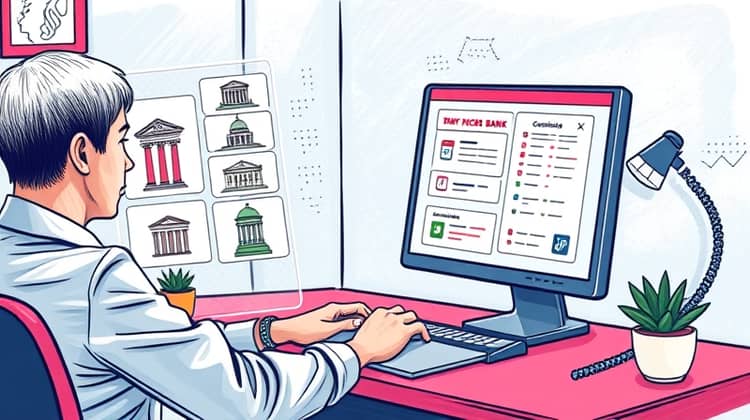Switching banks can seem like a daunting task, but it can also lead to better banking options that meet your evolving needs. Whether you're looking for lower fees, better interest rates, or a more convenient banking experience, knowing how to switch banks efficiently is essential. In this step-by-step guide, we'll walk you through the process to ensure a seamless transition from your old bank to a new one.
Start by understanding what you're looking for in a bank. Assessing your banking needs means identifying which services matter most to you, such as online banking capabilities, customer service quality, and branch accessibility. This guide will help you explore your options and make an informed decision.
Assess Your Banking Needs

Before deciding to switch banks, it's crucial to conduct a thorough assessment of your banking needs. Make a list of the features you value the most, such as account types, fees, and services. Consider what you currently like and dislike about your existing bank to better understand what to look for in a new one.
Reflecting on your personal finances can help you determine whether you need a checking account, savings account, loans, or investment services. Prioritizing these needs will guide your research on potential banks and help you choose one that aligns with your financial goals.
- Types of accounts needed (checking, savings, etc.)
- Fee structures and account minimums
- Access to ATMs and branches
- Online banking features
- Customer service quality
With a clear list of your banking needs, you can move on to exploring different banks that meet those requirements.
Research Potential Banks

After assessing your banking needs, the next step is to research potential banks that align with your criteria. Start by looking at both traditional banks and online-only options, as each offers unique benefits. Reading online reviews and rating comparisons can help you gauge customer satisfaction and service quality.
Pay close attention to the specific features and services that each bank offers. Make a shortlist of potential candidates, and consider setting up meetings or phone calls with bank representatives to address any questions you may have. This direct interaction can provide valuable insight into their customer support and overall service.
- Check online reviews and ratings
- Compare fees and services offered
- Consider bank branch locations and ATM access
- Look into online banking features and apps
- Assess the bank's reputation
Once you have conducted your research, it's time to narrow down your options to a few banks that seem like they would be a good fit.
Gather Necessary Information

Before opening a new account, it’s essential to gather the necessary documentation and information that banks typically require. This can include personal identification, Social Security numbers, proof of address, and information from your existing bank regarding your account details.
Being prepared with this information will help expedite the process of setting up a new account and ensure a smooth transition.
- Government-issued ID (driver's license, passport)
- Social Security number
- Proof of address (utility bill, lease agreement)
- Current bank account information
- Contact details
With all your documents in hand, you are ready to proceed to open an account at your chosen bank.
Open an Account at the New Bank

To initiate the account opening process, visit your selected bank’s branch or their website. If you’re opting for an online bank, be prepared to complete the application virtually. Make sure to follow all steps provided by the bank and fill out the required forms accurately to avoid delays in account activation.
You may also need to make an initial deposit to activate your new account. Familiarize yourself with the bank's policies regarding minimum openings, fees, and terms to ensure everything aligns with your expectations.
Transfer Funds

Once your new account is open, the next step is to transfer your funds from your old bank. You can accomplish this by writing checks from the old account and depositing them into the new account, or you can use electronic transfers for quicker access. Make sure to transfer your money gradually to avoid any issues while you adjust to your new banking setup.
During this transfer period, it’s wise to keep some funds in your old account to cover any pending transactions or withdrawals. Additionally, monitor both accounts closely to ensure that all funds have been successfully transferred and cleared before closing your old account.
When transferring your funds, you should consider the timing of your transfers. For instance, you might want to initiate transfers at the beginning of the month if you want to avoid direct deposit issues or their associated fees at the end of the month.
Change Direct Deposit and Automatic Payments

After transferring your funds, you’ll need to update your direct deposit information for your paycheck, government benefits, or any other income streams. Contact your employer or financial institutions to provide them with your new account details to avoid disruptions in your income flow.
In tandem with updating your direct deposit, assess your automatic payments. Make a list of your monthly bills, subscriptions, and auto-pay arrangements linked to your old bank account to ensure you can seamlessly transition these payments to your new account.
Update Linked Accounts and Subscriptions

It’s important to remember any accounts or subscriptions linked to your old bank account as you transition to your new bank. This includes services such as utilities, streaming platforms, loan payments, and more. Keeping track of these will prevent payment issues and late fees.
To ensure a smooth transition, create a meticulous list of all linked accounts and subscriptions. Going through your bank statement can help you identify them, making the updating process easier on your part.
- Review bank statements for linked accounts
- Update accounts with new bank information one at a time
- Confirm successful updates with service providers
By staying organized and proactive in making these updates, you will reduce the risk of missing payments or encountering issues as you switch banks.
Close Your Old Account

After confirming that all necessary funds have been transferred and automatic payments have been redirected, it’s time to close your old account. Visit your former bank's branch or contact their customer service to initiate the account closure process. Make sure to request any final paperwork or confirmation for your records.
Be cautious and ensure that no outstanding checks or pending transactions are linked to your old account before finalizing the closure. Once closed, keep an eye on your old account to ensure it accurately reflects the status of your closure and that no unexpected fees appear. This step is crucial to prevent any potential issues down the road.
Generally, banks will have various policies regarding account closures, including waiting periods or the necessity to visit a physical branch. Understanding these policies in advance can help you plan accordingly and avoid frustration during the closure process.
Tips for a Smooth Banking Transition

As you navigate the process of switching banks, consider utilizing these practical tips for a smoother transition. Remember, detailed organization goes a long way when managing your finances, especially when changing banks.
Take the time to double-check all updates you make during the transition process, from account links to direct deposits. Keeping records and receipts of everything will provide you peace of mind as you settle into your new banking arrangement.
- Make a checklist of tasks to complete during the transition
- Keep a timeline for when each task needs to be done
- Have a backup plan for any discrepancies or delays
By being thorough and vigilant, you can minimize the disruptions commonly associated with switching banks.
Conclusion

In conclusion, switching banks may require some initial effort and diligence, but it ultimately allows you to seek better banking services that fit your needs. From assessing your banking requirements to following through with the closure of your old account, each step is crucial for a successful transition.
With the proper planning and execution, the process can be relatively painless and beneficial, leading to a banking relationship that offers greater satisfaction and peace of mind.














